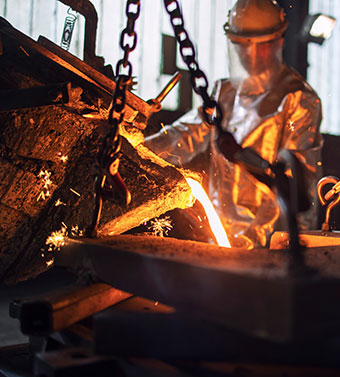Don’t let legal penalties and fines shut down your secondary aluminum process – Get OSHA compliant
Secondary aluminum processes generate substantial amounts of toxic dust and fumes containing carcinogens like lead, cadmium, chromium, nickel, and silica. Working in areas with high dust generation like below, increases the risk of inhaling particulates if they are not properly extracted.
- Furnaces generate dust and fumes during the melting of aluminum scrap. These can include particulates from the scrap itself and from any coatings or contaminants on the scrap.
- During casting and dross processing, dross can create significant amounts of dust. This process often includes crushing and grinding, which further increases the need for effective dust collection.
- When aluminum scrap is shredded and prepared for melting, the process can release dust and other particulates.
- Any post-casting machining operations can also produce aluminum dust that needs to be controlled.
- If the secondary aluminum process involves surface treatments like sandblasting, painting, or coating, these areas can also be sources of dust and fumes.
- The transport and storage of aluminum scrap and finished products can also generate dust, particularly if the materials are abrasive or friable.

In each of these areas dust can be as fine as PM 2.5, making them particularly hazardous. Nederman has dust collection solutions to capture and remove particulates from the air and at source to protect worker health, meet environmental regulations, and maintain product quality.
There are severe health effects associated with inhalation of these dusts including:
- Respiratory issues such as chronic coughing, wheezing, shortness of breath, pulmonary fibrosis, asthma, and even lung cancer.
- Neurological effects such as loss of cognitive functions and coordination and potentially Alzheimer’s.
- Silicosis which causes permanent lung scarring
- Aluminum Fume Fever which can have similar symptoms as the flu
- Skin and Eye irritation

If your workers experience symptoms like the above, you may be looking at lawsuits as well as other legal penalties and fines from OSHA very quickly.
Some key OSHA regulations and guidelines for dust to get compliant with in secondary aluminum processing areas are:
General Duty Clause (Section 5(a)(1) of the OSH Act):
Summary: This clause requires employers to provide a workplace free from recognized hazards that are causing or are likely to cause death or serious physical harm. Dust hazards, if not properly controlled, can fall under this category.
Solution: By effectively removing dust from the workplace, baghouse dust collectors contribute to providing a work environment free from dust hazards that could cause serious harm.
Air Contaminants Standard (29 CFR 1910.1000):
Summary: This standard sets permissible exposure limits (PELs) for various airborne contaminants, including metal dusts. Employers must ensure that worker exposure to dust does not exceed these limits.
Solution: Baghouse dust collectors effectively capture and remove airborne particulates helping maintain the concentration of dust below the permissible exposure limits set by OSHA.
Respiratory Protection Standard (29 CFR 1910.134):
Summary: If dust levels exceed permissible limits and cannot be controlled through engineering controls alone, employers must provide appropriate respiratory protection to affected workers.
Solution: Nederman can control dust at its source and minimize the need for personal protective equipment. This can lessen the reliance on respiratory protection for workers or supplement it when necessary.
Personal Protective Equipment (PPE) Standard (29 CFR 1910.132):
Summary: This standard requires the use of appropriate personal protective equipment, including eye and face protection, to protect workers from dust hazards.
Solution: While baghouses reduce the need for PPE by controlling dust, they also ensure that when PPE is used, it is more effective due to the lower levels of airborne particulates and reduces heat stress from higher PPE load.
Housekeeping (29 CFR 1910.22):
Summary: Proper housekeeping is essential in controlling dust levels in the workplace. This regulation requires employers to keep work areas clean and free from dust accumulation that could pose a hazard.
Solution: Proper dust collection helps maintain cleaner work areas and reduces the need for manual cleaning. Nederman has solutions for at source fume and dust collection and housekeeping equipment.
Combustible Dust National Emphasis Program:
Summary: While not a standard, this OSHA program focuses on inspecting facilities that create or handle combustible dusts, which can include certain types of metal dust. Aluminum dust is one of the most combustible dusts. This program aims to reduce the risk of dust explosions.
Solution: Baghouses are effective in capturing potentially combustible dust. Nederman has combustible dust mitigation equipment alongside our baghouses to ensure if a deflagration occurs the damage will be minimal.
Since specific conditions and operations can vary greatly, it's important for each facility to assess its unique risks and implement appropriate dust control measures accordingly. Nederman has helped many foundries and smelters assess their risk and become compliant with OSHA regulations, enhancing both worker safety and environmental health.
Contact us today for an assessment and solutions to protect your workers and facilities and avoid legal penalties and fines.
Contact us to create your custom solution
Call us at: 704-859-2723 or fill out the form below.